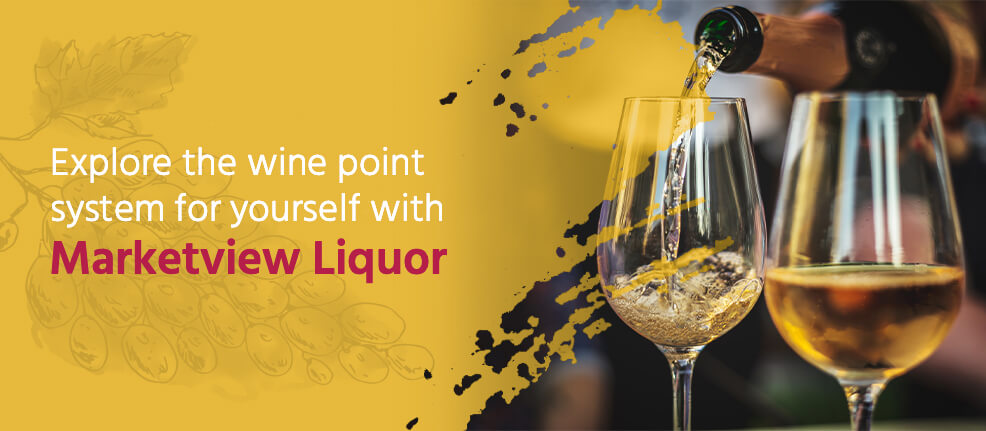
Those numbers you spot when shopping for wine? That’s a wine’s “score,” and it relays how that particular bottle’s characteristics fare within a set wine point system standardizing the wider industry.
What is the point system used for wine? Where did it start, who gives the ratings and how do points affect pricing, production and more? And — perhaps most importantly — should you even care about wine ratings in the first place?
Get the 4-1-1 on the 100-point wine scoring system with this guide — ideally, while you’re sipping your favorite varietal.
Table of Contents
- How Did the 100-Point Wine Rating System Begin?
- The Purpose of the Wine-Scoring System
- Critiques of the 100-Point Wine-Rating System
- Who Scores Wines?
- What’s a Wine’s Score Based On?
- What If a Bottle of Wine Doesn’t Have a Number?
- How to Pick the Best Wine
- Explore the Wine Point System for Yourself
The Wine Point Scale, Explained
What is the wine point system, and how does it work? The wine rating scale is a 100-point-based system. A higher score reflects a consensus from various wine experts that a bottle is of excellent quality, whereas low scores — logically— denote an average or less-than-stellar bottle.
Wine ratings are more a point of reference than an official decree. Consumers like you can use the numbers to weed out specific bottles when browsing wine in a store or online, to compare identical varietals from different producers or to have fun testing your palate against the “experts.” In any case, wine ratings are ultimately subjective — a helpful tool to take and use as you wish.
How Did the 100-Point Wine Rating System Begin?
The wine rating system out of 100 that is so well-known today began in the 1980s, when respected wine writer and critic Robert Parker established a scorecard to review his wine-tasting assignments consistently.
Parker’s approach was pragmatic. Given the many characteristics expressed in a single glass of wine — and the amount of wine his job required him to taste — Parker needed a standardized system to base his judgments on. According to lore, he used a familiar, school-based grading scale as inspiration for his methodology. Like a math or spelling test, grades in the 90s or above are exceptional, while 80 to 89 are passing or above average and wines below 70 are a miss.
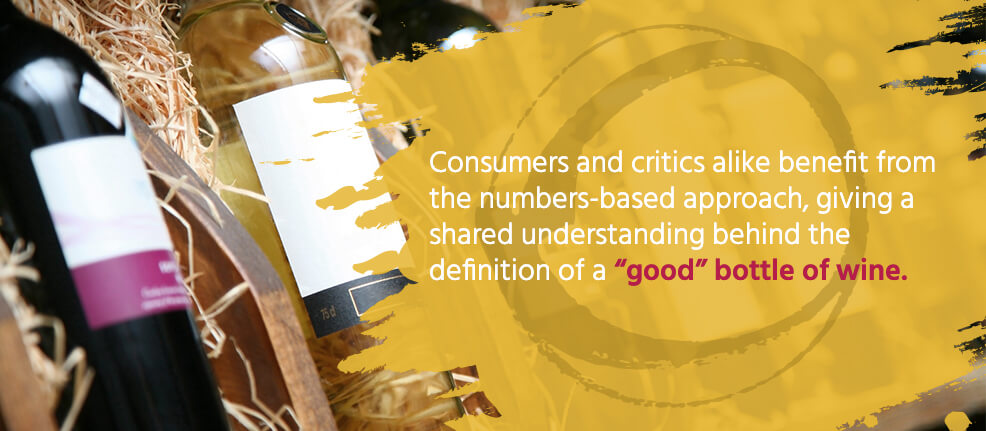
Initially, fellow wine critics admonished Parker’s scorecard for oversimplifying the wine-tasting experience. However, Parker’s method soon gained traction across premier publications like Wine Spectator, Decanter, Wine Enthusiast and many more, leading to its establishment as the leading wine-scoring and -ranking system used globally. Consumers and critics alike benefit from the numbers-based approach, giving a shared understanding behind the definition of a “good” bottle of wine.
Today, a high score — think 97 points or above — from a premier wine publication can be life-changing for the wine’s producer, bombarding them with orders and radically altering the production, scale and name-brand reputation of their vineyard.
The Purpose of the Wine-Scoring System
The idea behind a wine-rating scale is functional: to standardize wine-tasting information and consumption. Standardization does not mean to make the world of wine boring and uniform, or to remove the nuance, complexity and individual preferences and experiences associated with a successful wine tasting. Instead, the scorecard provides a quick and straightforward way for critics and consumers alike to have realistic expectations about their wine purchases.
Think of the 100-point wine-rating scale as a Rosetta Stone for communicating wine. Across languages, varietals, regions and tastes, the point system used in wine ensures everyone has an understanding of a bottle’s quality.
How Are Wines Rated and Scored?
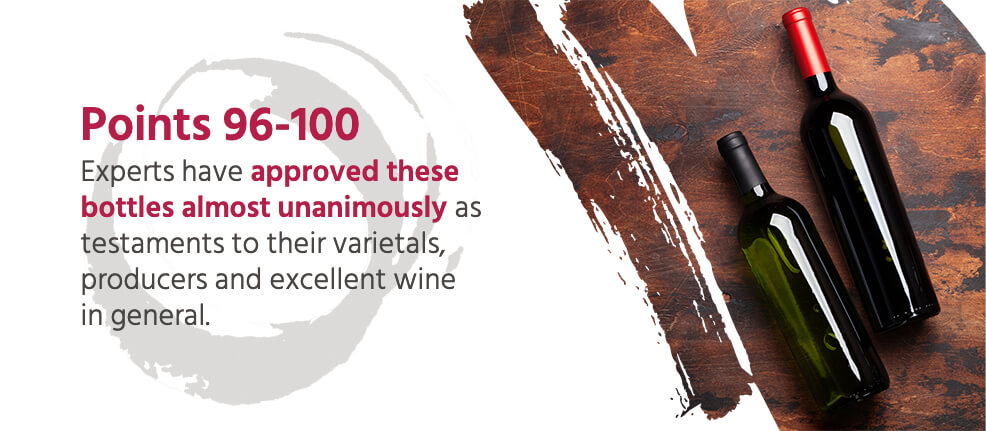
How is wine rated with points? The 100-point wine-scoring system breaks down as follows.
- 96-100: Wines with a rating of 96 and above are in the upper echelons of quality. Experts across premier publications have approved these bottles almost unanimously as testaments to their varietals, producers and excellent wine in general. Receiving a ranking between 96 and 100 is one of the most significant accomplishments in the wine world.
- 90-95: Bottles rated in the 90-to-95 range come highly recommended by critics and consumers alike, representing a bottle with beautiful depth, character, flavor and bouquet.
- 85-89: Wines in the mid- to upper 80s demonstrate the quintessential characteristics of their region or varietal. They are often well-priced and above-average in quality, making them an ideal choice to pair with special meals and occasions without breaking the bank.
- 80-84: Bottles rated in the 80-to-84 range are best for everyday enjoyment, rather than celebratory events. Again, this rating indicates a solid bottle of wine suitable for casual drinking, but may not carry the finesse of higher-rated varieties.
- 70-79: Wines rated in the 70s meet the standards for drinkability. They check off the fundamental tenets for their varietal or region, but lack the depth, consistency, aroma, taste, finish and aging techniques of higher-rated bottles.
- Below 70: Experts generally consider bottles rated below 70 to have some critical flaws, and do not recommend them for consumption.
This numeric system relies on a bottle of wine receiving enough reviews from major wine publications, sommeliers, food critics, renowned wine blogs and others in the industry. The longer a bottle has been in production, the more reviews it’ll amass.
Together, a bottle’s scores across publications and reviews translate into that number you see when shopping for wine. Most liquor stores either advertise the rating from one specific publication such as Wine & Spirits Magazine or Wine Spectator, or will calculate a bottle’s average based on several publications’ reviews.
Critiques of the 100-Point Wine-Rating System
The 100-point wine rating system is not perfect. Many have pointed out that wine rated with rote numbers courts several inconsistencies, including the following.
- Subjectivity: The onus behind today’s ever-popular points-based system is to craft a concise, standardized way to review bottles of wine. It’s impossible, however, to prevent subjective biases from creeping into scoring — particularly for metrics like a wine’s overall bouquet, its primary and secondary aromas and the flavors the drinker tastes.
- Weight of points: Few wines get rated under 85 points. As some critics have noted, if a system categorizes the vast majority of bottles in a narrow range that’s nearly always above average, it defeats the purpose of the entire ranking system. What’s more, bottles rated in the low 80s or below rarely broadcast that score, since that would — in essence — signal their inferiority.
- Scale range: Parker’s scoring rubric awarded 50 points to every wine he tasted. That means every bottle automatically begins with a baseline of 50 points, working up from there. Again, critics believe it defeats the purpose of wine scoring if the system starts at the halfway range, rather than a neutral zero.
- Marketing side effect: Parker never intended for the wine points system to turn into a powerful mass-marketing tool. Today, though, new wines rated in the 96-to-100 range often trigger an all-out order deluge on the producing winery. Many are ill-equipped to handle that frenzy, which ultimately detracts from the quality of the very wines lauded as exceptional.
- Simpler points-based systems: Alongside Parker’s 100-point wine system, there are five-point and 20-point review methods where scoring starts at zero. These methods of rating wines remain less widespread than the 100-point scale, though.
- Gaming the system: Winemakers took note as Parker’s wine rating and scoring system gained traction. Starting in the 1990s, some began tracking and analyzing the scoring patterns of major critics and publications. Wine producers then used that data to label their bottles “international style,” i.e., explicitly crafted to score well under Parker’s system. This phenomenon triggered what’s now known as the “Parkerization” of mass-marketed wines, with producers delivering products explicitly aimed at Parker’s perceived palate, rather than striving for uniqueness, creativity and nuance.
Who Scores Wines?
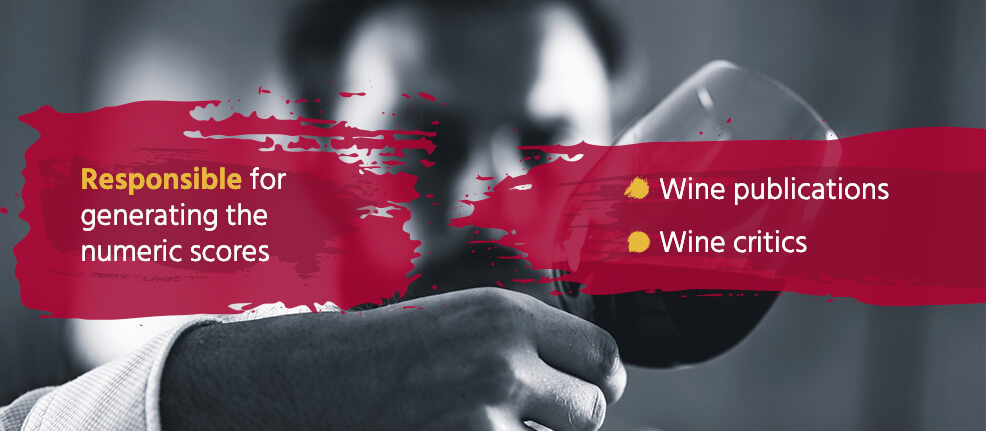
There are several major players in the wine industry responsible for generating the numeric scores you see when shopping for wine.
- Wine publications: Premier industry publications such as Wine & Spirits Magazine, Wine Spectator, Wine Advocate, Decanter Magazine, Vinous, The Wine Cellar, The Wine Cellar Insider and more write continual reviews of bottles using the wine rating scale as their guiding metric. Most liquor stores cite these publications for the bottle ratings you see advertised when browsing shelves.
- Wine critics: Renowned wine critics at the top of their field also personally rate wines. Many release their rankings across proprietary publications, in books or in reviews for major wine magazines and websites. These influential critics include names like James Suckling, Jancis Robinson, Jamie Goode, Jeff Leve, Julia Harding, Antonio Galloni and many more.
Wine scoring occurs continually with publications and wine critics alike. Regardless of who’s performing the tasting, though, the wine-rating methodology goes as follows.
- Blind tasting: Wine scoring takes place blindly. Bottles have all labels and identifying branding removed, as well as their retail price. Reviewers pour samples into neutral, clear glasses to taste at their pace.
- Scorecard metrics: Most formal wine reviews will use an identical scorecard to guide tasting. Reviewers use the scorecard as a checklist for how to rate wines on a 100-point system, with a series of traits and criteria for each to analyze, then assign a numeric score to. These exact wine traits reviewers look for are detailed below, in the “What’s a Wine Score Based On?” section of this guide.
- Score calculation: There are two methods for calculating that number you see on a bottle at your local wine or liquor store. First, a store may choose to adopt a single publication’s or critic’s reviews, advertising their rating exclusively. Second, a store may calculate an average score for bottles based on several publications and critical reviews, then broadcast a weighted total.
An Essential Note on the Wine-Scoring System
In general, wine publications tend to provide scorecards for their reviewers to help standardize results and provide the most objective tasting possible.
However, reviewers can still introduce additional rubric elements, as well as note other subjective qualities not included on a set scorecard. The industry encourages tasters to prioritize the following during a formalized wine ranking:
- Appearance
- Aroma/bouquet
- Flavors
- Finish
Continue reading to understand how the wine point system works on a more profound level — specifically, the exact criteria tasters use to formally rank wine.
What’s a Wine’s Score Based On?
Parker’s 100-point wine-rating system emphasizes the following traits. Explore each characteristic the next time you open a bottle of your favorite cabernet sauvignon or chardonnay— or that never-before-tried fancy French Chenin Blanc you picked up just because.
Description
1. Appearance
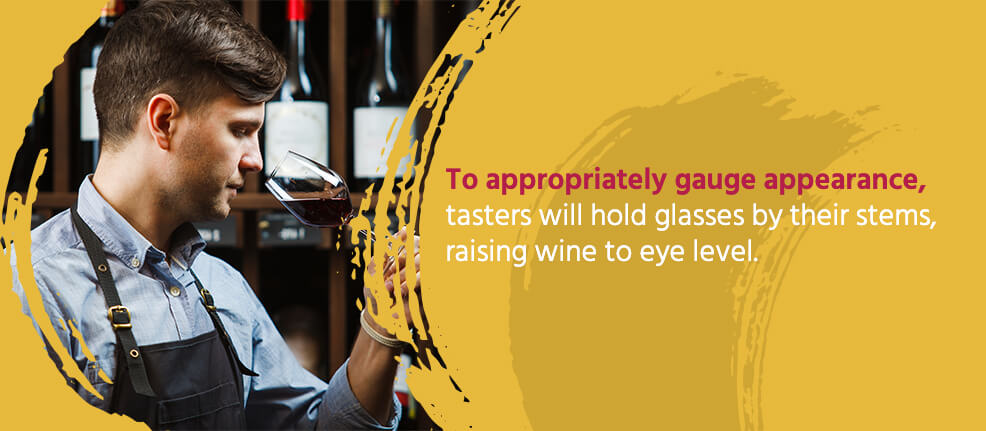
A wine’s appearance is a broad, but essential, opening category when rating a bottle.
To appropriately gauge appearance, tasters will hold glasses by their stems, raising wine to eye level. Doing so allows a reviewer to assess the following.
- Core and rim: A wine’s core will be its main body color. Conversely, its rim is the topmost perimeter color, where the wine meets the edge of the glass. Both core and rim colors mirror the quality of a varietal, as well as hint at possible aging techniques.
- Color: How are red wines rated? Every type of wine varietal — e.g., pinot noir, merlot, sauvignon blanc, etc. — has an associated color scheme. While shades and hues will vary based on the varietal’s region as well as how aged the wine is, reviewers will note how well their sample’s color represents its varietal’s nature.
- Viscosity: The best way to assess a wine’s viscosity is to give the contents of your glass a good swirl. Watch to see how quickly or slowly wine droplets move down the glass. The more slowly they move, the more viscosity — or “legs” — the wine has, which generally indicates higher ABV as well as a sweeter wine.
- Opacity: Opacity refers to how clear or dense a wine looks in its glass. Again, specific varietals should be more opaque than others, indicating differences in their care and quality.
2. Consistency
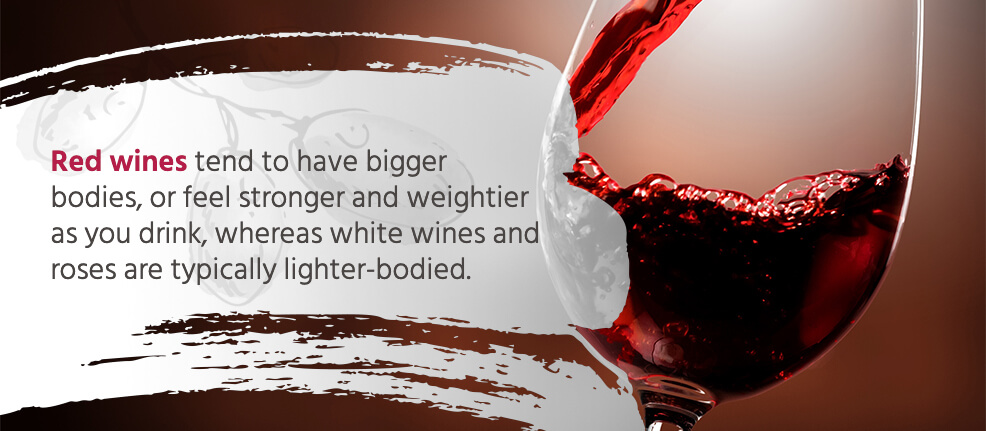
A wine’s consistency, often referred to as its “mouthfeel,” is a broad term that identifies how a wine feels on your tongue as you drink. The most common traits associated with a wine’s mouthfeel or consistency include the following.
- Body: Wines can be light, medium or full-bodied. Red wines tend to have bigger bodies, or feel stronger and weightier as you drink, whereas white wines and roses are typically lighter-bodied.
- Density: Dense wines might feel heavier, prickly or more astringent, causing a sensation many describe as “chewy.” On the other hand, light wines may feel leaner or juicier to drink.
3. Nose
A wine’s “nose” refers to how it smells, or its total olfactory profile.
Tasters use two primary categories to identify a good-quality nose on a glass of wine, as well as the complexity and balance of these overall smells.
- Bouquet: A wine’s bouquet is the specific aromas you smell after opening the bottle. It is a unique experience more open to subjective perceptions.
- Aromas: A wine’s aroma is varietal-specific, meaning some types of wine will have specific smells associated with each. Aromas are more objective and universal.
4. Taste
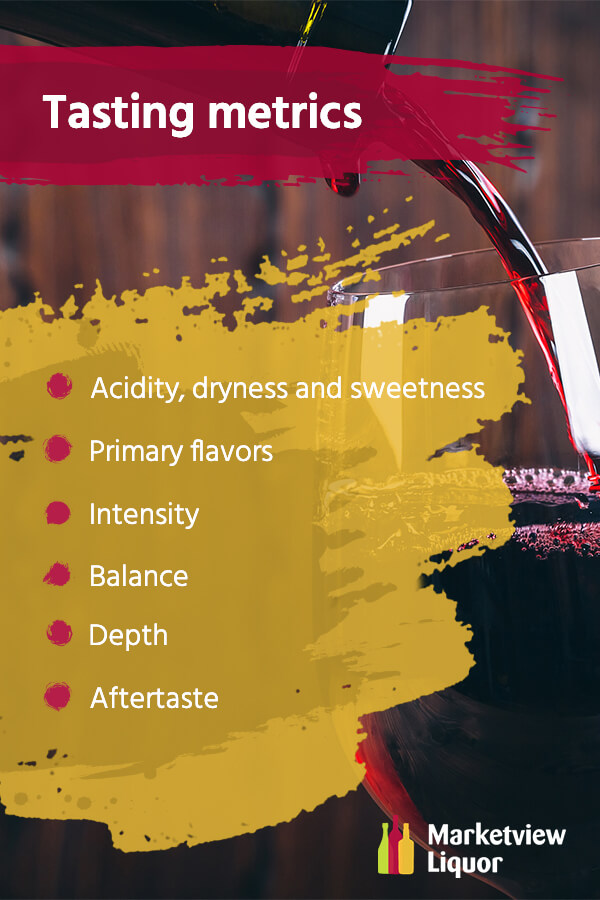
Taste is one of the defining qualities for rating wine — for understandable reasons. What reviewers taste will be subjective, but rating scorecards outline a few definitive tasting metrics.
- Acidity, dryness and sweetness: Acidity, dryness and sweetness are three essential qualities for any type of wine. It’s possible to define many varietals by these traits. For example, white zinfandels are notoriously sweet, while sauvignon blanc is one of the driest types of wine available.
- Primary flavors: Primary flavors include the fruits, vegetables, herbs, spices and other food notes a wine is reminiscent of. Common flavor examples include things like berries, currants, tobacco, chocolate, cherries and leather.
- Intensity: Tasters will note the depth and strength of a wine’s primary flavors, as well as where those flavors hit on the tongue.
- Balance: A well-balanced wine displays appropriate levels of tannin, sweetness, acidity and alcohol. Balance is one of the critical factors in determining a wine’s awarded points.
- Depth: Wines with depth are vibrant and multidimensional, whereas those lacking depth may taste flat or one-noted.
- Aftertaste: A wine’s aftertaste includes its final flavors as well as how long its taste lasts in your mouth, i.e., its finish. A long finish tends to correlate with higher-quality wines, not because the wine itself is stronger, but because its flavors are multifaceted and well-rounded.
5. Complexity
Another broad, but essential, term, complexity refers to how dynamic a wine’s drinking experience is. For example, a complex wine will display several primary flavors and aromas alongside appropriate tannin levels, acidity, sweetness and alcohol, wrapped up in a long-lasting, balanced finish.
Critics use wine complexity as a bit of a catch-all. In general, complexity describes the overall impression a wine leaves you with. While imprecise and open to subjectivity, it remains a critical factor in the wine point system.
6. Varietal Representation
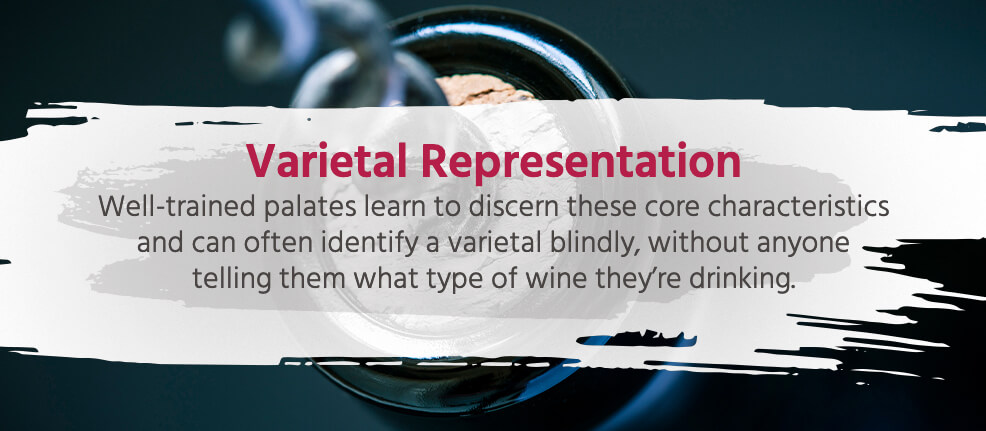
Experts will also consider how well a bottle represents its varietal, or the grape types used to make it.
Every grape varietal contains a unique set of characteristics. Well-trained palates learn to discern these core characteristics and can often identify a varietal blindly, without anyone telling them what type of wine they’re drinking. Those holding advanced sommelier certificates must undergo several rounds of such blind taste tests before earning their accolades.
When rating wine, drinkers must have some background on the nature of that varietal to compare the individual bottle to. This knowledge gives credence to the final rating, signifying a bottle is an excellent representation of its namesake grapes.
7. Room for Improvement
Last but not least, wine reviewers can make notes on how they believe a winery could improve its product. While this stage of a wine ranking does introduce personal bias, esteemed critics and publications take every precaution to be specific in their suggestions, recommending improvements that are fair and actionable, rather than pure opinion.
Remember that you, as a consumer, get the final say on wines to enjoy. The rating scale is merely a reference tool meant to help distinguish and discern bottles amid the sometimes overwhelming choices available to consumers today. All tastes and scores are, ultimately, subjective — never a mandate signaling to drink or not to drink.
What If a Bottle of Wine Doesn’t Have a Number?
Unrated wines do not mean a bottle is so bad it doesn’t deserve a number. Instead, wines without a rating can be due to several situations:
- It’s a freshly produced vintage no major publication or critic has reviewed yet.
- It’s a new wine blend.
- It’s a new vineyard or producer.
- It’s an exclusively produced wine, available only in specific regions, stores or retailers.
How to Pick the Best Wine
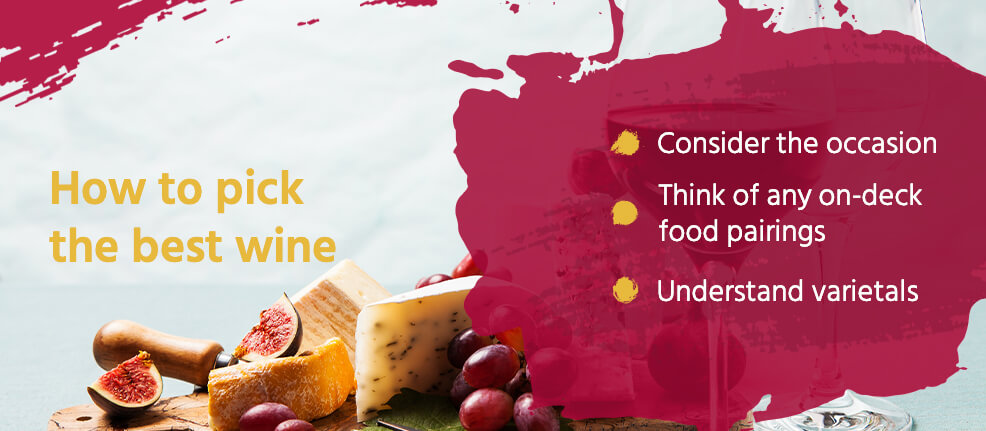
Selecting the best wine possible doesn’t need to be complicated. Keep in mind any of these wine-choosing tips and tricks next time you’re shopping for a few bottles, then feel more confident with your purchase.
- Consider the occasion: Will this be your go-to nightcap, a casual drink with friends, something to impress the in-laws, etc.?
- Think of any on-deck food pairings: Are you serving wine with a meal or enjoying it as a stand-alone beverage?
- Understand varietals: Know the types of wines you prefer, as well as where they’re from — then get selective.
Only after these considerations should you reference a bottle’s point ranking, ultimately going with your gut.
Explore the Wine Point System for Yourself
Take all wine point systems and ratings with a grain of salt. The wine world is constantly evolving, as are the trending flavors and varietals. In the end, a good wine is one you enjoy drinking. It’s that simple. Really.
Use our “By Points” filter to shop for wines based on critical ratings. Or, browse our extensive online wine catalog according to other preferences like wine type, price, region — even case discounts for select bottles.
It’s a good idea to ensure that you are pairing your rated wine well. Take our Wine Pairing Quiz to find the perfect pairing for your next bottle.
Try top-rated wines from Marketview Liquor and order online today for home delivery.
